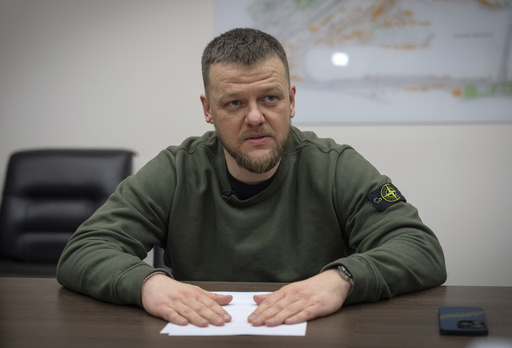
ZAPORIZHZHIA, Ukraine — Nestled within a partially occupied area of Ukraine, the sprawling Zaporizhstal Iron and Steelworks resembles a dystopian city filled with flames, conveyor belts, and winding pipes. Here, intense bursts of sparks erupt from open furnaces, where dedicated workers continuously transform iron ore into molten metal, day and night.
As one of Ukraine’s largest steel plants, Zaporizhstal is located in the eastern industrial part of the country, currently poised on the brink due to the three-year-long Russian invasion. The ongoing conflict manifests in fierce battles occurring just 40 kilometers (25 miles) away, amidst the plant’s relentless operation to produce materials critical for military endeavors alongside products used by foreign manufacturers in sectors ranging from automotive to construction.
Despite the constant activity, morale among the workers has dipped, according to plant supervisor Serhii Zhyvotchenko. “We are pretty tired here,” he remarked, emphasizing the toll the situation has taken. “But there is no way to go back; the only way is forward.”
Recently, the factory faced an additional challenge: a potential trade dispute following U.S. President Donald Trump’s recent return to office and subsequent decision to impose tariffs of at least 25% on all imported steel and aluminum. This move has alarmed Ukrainian officials and industrial leaders, as it threatens to exacerbate issues in a sector already crippled by war and instability.
On February 10, Trump’s executive order shocked many in Ukraine, highlighting their increasing vulnerability concerning their key ally, the United States. The president argued that his tariffs would enhance competitiveness within U.S. industry and create a more level international playing field. However, the economic impact could be devastating. Since the onset of the invasion, Ukraine’s steel industry has seen its contribution to the GDP shrink by almost half, with exports falling sharply below pre-war figures.
The Ukrainian Steel Association has raised alarms that the implementation of these tariffs on March 12 would cost the already weakened sector 2.4 billion hryvnias (approximately $58 million) in revenue and deprive the government of around 1 billion hryvnias ($24 million) in tax income annually. Alongside these tariff concerns, Trump stirred further unease by engaging in direct communication with Russian President Vladimir Putin, posing risks that past diplomatic isolation attempts could be undermined.
Trump’s intentions to meet with Putin in the near future heightened fears in Kyiv regarding their exclusion from potential ceasefire negotiations. Furthermore, statements by both Trump and U.S. Defense Secretary Pete Hegseth regarding NATO membership for Ukraine have left officials apprehensive about U.S. support.
In a bid to secure continued U.S. assistance against Russian aggression, Trump mentioned his interest in Ukraine’s rare earth materials. Meanwhile, Ukrainian Economy Minister Yulia Svyrydenko expressed a willingness to engage U.S. officials collaboratively to preserve access to the vital American steel market.
Ukraine is advocating for a temporary exemption until March 2026 for domestic steel products and for those produced in the EU from semi-finished Ukrainian steel. The government argues that Ukrainian steel imports represent a minimal fraction of total U.S. imports and pose no significant threat to domestic industries.
Ensuring the exemption for Ukrainian steel, including that processed in the EU, is critical in supporting Ukraine amid ongoing military threats, the Ukrainian Steel Association has stated. This support is necessary for sustaining operations and bolstering the national economy.
At the Zaporizhstal plant in southeastern Ukraine, iron smelting is just the initial phase in a large-scale procedure culminating in millions of tons of cast iron and steel destined for international markets. As Zhyvotchenko approaches the blast furnace, the scorching heat soars to approximately 2,000 degrees Celsius (3,632 degrees Fahrenheit), where workers in protective gear skillfully manipulate streams of liquid steel, akin to medieval knights in battle.
Since the Russian invasion, workers have faced a grueling challenge: producing more with diminished resources. The plant runs at 75% capacity, with 12% fewer personnel due to drafts into the Ukrainian military or departures abroad, according to Metinvest Group, the plant’s owner.
The production process has become increasingly complicated as Metinvest lost control of two essential steel facilities during the Russian siege of Mariupol in 2022 and faced further losses with recent advances in Donetsk. They have had to suspend operations at their Pokrovsk mine and evacuate staff amidst these developments. To maintain operations, the Zaporizhstal mill now depends on the importation of 1 million metric tons of coal annually from Europe and the U.S.
The ongoing war has intensified existing issues, leading to skyrocketing energy costs resulting from persistent attacks on Ukraine’s energy infrastructure. Trade routes have also been disrupted by bombings and blockades, necessitating a pivot in focus from Asia and the Middle East towards European customers—a transition described as painful by general manager Taras Shevchenko.
Given that Europe now constitutes the largest market for Ukrainian steel exports, Ukraine aims to involve the EU in its tariff exemption discussions. Concerns have emerged that the U.S. steel tariffs may prompt European nations to impose their import duties on Ukrainian goods as a countermeasure.
“Such actions would significantly impact us,” acknowledged Oleksandr Myronenko, Chief Operating Officer of Metinvest Group.
With Europe accounting for approximately 80% of Metinvest’s export products and operating a facility in Bulgaria—where steel typically exported to the U.S. is produced—there are fears that tariffs could sharply diminish demand for these products.
As workers grapple with uncertainty, they remain hopeful for a stable future. Zhyvotchenko observed heavy ladles being transported for refining, a signal of ongoing production cycles. “We can be tired, we can be tense, we can be anything, but we must endure and must work,” Myronenko asserted, encapsulating the resolve of those laboring under challenging conditions.

